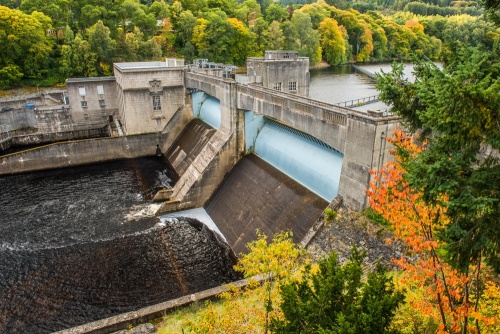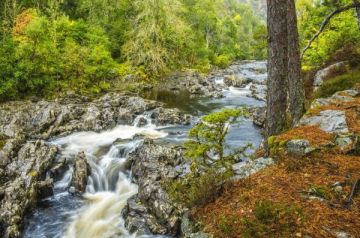
The Tummel Valley region of Perthshire was one of the first areas in Scotland to be developed for hydro-electric power. The first power stations in the area were built in the 1930s by the Grampian Electricity Supply Company.
Those early power stations were later integrated to form the Tummel Valley hydro scheme, a network of linked hydro plants along the River Tummel and its tributaries. The Tummel Valley scheme collects water from the Grampian Mountains and funnels it through a network of reservoirs and hydroelectric power stations.
As the water travels downhill to the sea it can be used again and again to generate electricity. The same water can be used up to five times to produce green energy.

The work in Perthshire was part of an ambitious scheme launched by the Hydro Electric Development (Scotland) Act of 1943 that saw 54 power stations, 78 dams and over 180 miles of tunnels constructed throughout the Highlands.
History
In 1947 construction began on a new hydro station at the Victorian spa town of Pitlochry. The Countess of Airlie laid the first block of stone on 26 April 1947. A plaque commemorating the ceremony stands at the northern end of the dam.
The scheme was publicly unpopular and aroused local opposition. After a public inquiry Parliament approved the scheme in 1945. The new scheme involved a dam at what is now the south-eastern end of Loch Faskally Reservoir on the River Tummel.
Pitlochry Dam took four years to construct and was hampered by winter flooding. The project was further delayed when construction workers went on strike over the poor quality food they were receiving. Construction finished on 10 January 1951 and an opening ceremony was planned for June of that year.
Sadly the Hydro Board's head engineer Sir Edward MacColl died just before the planned ceremony so it was put off. A much less elaborate ceremony was held in 1952 and a plaque commemorating Sir Edward was unveiled.

Pitlochry Dam is one of nine stations in the Tummel Valley hydro-electric scheme. It boasts two turbines which together supply electricity for 15,000 homes.
The dam's modern visitor centre stands on a hill above the dam and the River Tummel. In addition to a very popular shop and cafe overlooking the dam, the visitor centre has exhibits tracing the dam's construction and the history of hydroelectric power in the north of Scotland. The exhibits are extremely good and tell the sometimes tragic stories of the men and women who worked on major hydro-electric projects, including the Tunnel Tigers and the Hydro Boys.
The Fish Ladder
Most people visit Pitlochry Dam to see Atlantic salmon passing through the fish ladder in their annual return to spawning ground further up river. Salmon and sea trout return each year to the place they were hatched in order to lay new eggs. Without some way for the fish to bypass dams they would not be able to reach the spawning area and the fish population would quickly dwindle. Fish ladders provide a way for fish to bypass the dam.

The Pitlochry Fish Ladder is built into the southern side of the dam and consists of a stepped system of thirty-four small pools, each slightly higher than the last, that allow fish to swim around the dam and through the hydroelectric turbines to reach Loch Faskally on the other side.
Young salmon and sea trout pass directly through the turbines while screens keep larger fish clear. The turbine blades are designed like a revolving door, allowing the fish to pass safely. Since the fish ladder was opened in 1952 over 250,000 salmon have passed safely through.
Visitors can walk across the dam itself and take advantage of viewing windows to see into the huge chamber that houses the turbines. An observation chamber is built into one side of the fish ladder allowing visitors a good look at the salmon up close. There is also a 'fish counter' showing how many salmon have used the ladder that year.
The best time of year to see the salmon at Pitlochry Dam is from later September to November. Do be aware that the observation chamber can be closed for maintenance so it is a good idea to check ahead. That said, when we visited last the observation chamber was closed but we could still see salmon quite clearly from simply looking into the pools.

Getting There
The visitor centre is extremely easy to reach on foot from the centre of Pitlochry. Just follow the brown tourist signs off Atholl Road (the A924). There is a free parking area outside the centre. Alternatively, you can follow a footpath along the north bank of the river from the pedestrian suspension bridge off Ferry Road.
About Pitlochry Dam & Fish Ladder
Address: Armoury Road,
Pitlochry,
Perthshire,
Scotland, PH16 5AP
Attraction Type: Historic Building - Landmark
Location: At the end of Armoury Road, off the A924, or by footpath along the river from the pedestrian suspension bridge off Ferry Road
Website: Pitlochry Dam & Fish Ladder
Location
map
OS: NN935577
Photo Credit: David Ross and Britain Express
NEARBY HISTORIC ATTRACTIONS
Heritage Rated from 1- 5 (low to exceptional) on historic interest
Sunnybrae Cottage - 0.3 miles (Historic Building) ![]()
Black Castle (Caisteal Dubh) - 1 miles (Castle) ![]()
Pitlochry & Moulin Heritage Centre - 1 miles (Museum) ![]()
Dunfallandy Stone - 1.1 miles (Prehistoric Site) ![]()
Craigower - 1.8 miles (Countryside) ![]()
Linn of Tummel - 2.9 miles (Countryside) ![]()
Killiecrankie - 3.3 miles (Countryside) ![]()
Tay Forest Park - 4.3 miles (Countryside) ![]()
Nearest Holiday Cottages to Pitlochry Dam & Fish Ladder:
More self catering near Pitlochry Dam & Fish Ladder



